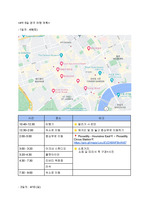WEBROOMING OR SHOWROOMING IN FASHION SHOPPING? A MATTER OF INVOLVEMENT
* 본 문서는 배포용으로 복사 및 편집이 불가합니다.
서지정보
ㆍ발행기관 : 글로벌지식마케팅경영학회(GFMC)
ㆍ수록지정보 : GFMC Session1
ㆍ저자명 : Carlos Flavián, Daniel Marín, Carlos Orús
ㆍ저자명 : Carlos Flavián, Daniel Marín, Carlos Orús
영어 초록
Introduction Consumers can easily combine the online and physical channels in their shopping process. This new reality is changing the nature of the customer-firm interactions and is challenging retailers to effectively manage their customers. In this line, two antagonistic shopping patterns can be identified: showrooming (visiting physical retailers to check out products and then buy online) and webrooming (research products online before making the purchase offline). In this way, the fashion industry has been deeply affected by these cross-channel shopping behaviour (Lee and Kim, 2008; Cho and Workman, 2010). In this way, according to the Google Consumer Barometer 2015 (www.consumerbarometer.com), webrooming represents the dominant channel combination in fashion shopping around the globe. Cross-channel shopping patterns can threaten traditional retailers though, in the form of free-riding behaviors, such that consumers use one retailer’s channel to prepare, and then switch to another retailer’s channel to purchase (Chiou et al., 2012). Both showroomers and webroomers can free ride, yet the latter is less problematic, because online retailers’ costs are largely fixed (Van Baal and Dach 2005), and consumers often use multiple online sources to search for product information. In an omnichannel era, retailers must learn to integrate channels to offer seamless and unique experiences that retain consumers throughout their entire purchase experience (Verhoef et al, 2015). However, there is a lack of studies analysing the situational characteristics that lead consumers to adopt a specific combination of channels. Specialised literature has emphasised the role convenience (e.g. Verhoef et al., 2007), overlooking the impact of other relevant factors. This research examines the differences between webrooming and showrooming in terms of the degree of the consumer’s involvement with the purchase. Specifically, we examine the differences between webrooming and showrooming in terms of involvement, and how these differences translate into different preferences for the virtual and physical channels to search for information and carry out the purchase. Hypotheses Formulation The consumer’s cross-channel behavior is defined as the use of a combination of channels at different stages of the same shopping process (Dholakia et al., 2005). As previously stated, showrooming and webrooming are two antagonistic forms of cross-channel behavior. We propose that the degree of involvement will shape the consumer’s tendency to carry out one of the two cross-channel sequences. Involvement is defined as the individual’s degree of interest or relevance with a product or purchase situation (Zaichkowsky, 1985; Mittal, 1989). The fashion industry encompasses products whose characteristics prevent consumers from evaluating their quality without physical interaction (Weathers et al., 2007). Thus, they are sensitive to be acquired by means of a cross-channel process. However, when consumers are involved with the purchase of the product, their informational needs are increased (Brunelle, 2009), which lead them to carry out an exhaustive information search. Purchase involvement entails that the consumer is motivated to choose the best option. In this way, the Internet is widely acknowledged as the best channel to satisfy consumers’ need for an extensive information search (e.g. Ratchford et al. 2003), except for the physical inspection of the product (Citrin et al., 2003). This lack of complete knowledge leads them to carry out a webrooming purchase process. On the other hand, when consumers are not involved with the purchase of the product, they seek for convenience in their experiences and paying a low price (McGoldrick and Collins, 2007), which are the main defining factors of showrooming. Showroomers go the physical store to find the product they want to acquire and then take the advantage of the convenience and low prices of the Internet to buy the product. Therefore: H1: Purchase involvement is higher in webrooming than in showrooming. For showroomers, the use of the Internet is more limited to the search for lower prices and to carry out the purchase. In webrooming, consumers use the Internet to research about products and then go to the store with a higher knowledge of the product they want, to corroborate the information they have seen online, and to gain power in the interaction with the salesman (Orús, 2015). Webroomers value the information richness that the Internet offers. Therefore, the relevance of the Internet as channel to search for product information should be higher in webrooming experiences than in showrooming experiences H2: The preference for the Internet to search for information about the product is higher in Webrooming than in Showrooming. Finally, if involvement determines the differences between webrooming and showrooming, it should also explain the preferences for the purchase channel. Specifically, highly involved consumers will be more likely to use the physical store because they can have a physical interaction with the product and the sales personal, which helps them to take the shopping decision with a high degree of confidence (Flavián et al., 2016). Low involved consumers will purchase from the channel which allows them to pay a low price and to make the purchase in a convenient way (i.e. the Internet). Thus: H3: The degree of consumer’s involvement with the purchase mediates the effects of webrooming versus showrooming experiences on the preference for the purchase channel. Methodology Three studies were developed to test the hypotheses. The Study 1 consisted of an exploratory survey to identify and characterise different cross-channel shopping behaviours. In Study 2 we directly manipulate the degree of the participants’ involvement in order to examine their preference for the Internet as a channel for searching for information and their preference of the channel to carry out the purchase. Finally, Study 3 put participants into a webrooming or a showrooming shopping scenario and examines differences in the degree of involvement and purchase intentions. All the studies are carried out with samples of millennials or Generation Y (Parment, 2013) and focus on the purchase of clothing and accessories. Study 1 Participants were 192 millennials (60.9% female; between 18 and 35 years old). They were asked to think about a recent purchase experience of clothing or accessories in which they combined different channels during the purchase process. The participants reported the product purchased and the channels employed to search for information and buy the product. Finally, they indicated, on a 7-point scale (1 = not at all, 7 = extremely), to what extent the purchase of the product was (1) important, (2) interesting, (3) relevant, (4) meant a lot, (5) significant, to measure their degree of involvement (Zaichkowsky, 1985; Mittal, 1989; α = 0.89, 70.51% of variance explained). Due to space constraints, only a summary of results is presented. Out of the 192 participants, 109 (57%) reported a webrooming experience, whereas 28 (15%) recalled a showrooming experience. This result confirms that webrooming is a more extended behavior than showrooming. Moreover, purchase involvement for participants who recalled a webrooming experience (M = 5.56, SD = 0.86) was significantly higher than for those who recalled a showrooming experience (M = 4.33, SD = 1.46; U Mann-Whitney non-parametric test: p < 0.001). Evidence in favor of H1 was found. Study 2 This study consisted of an experimental design with one between-subjects factor with two levels. Specifically, participants (n = 68; 58% female; between 18 and 35 years old) were asked to think about the purchase of a clothing and fashion product with a cost of either €20 or less (low involvement condition) or €100 or more (high involvement condition). Among other measures, participants reported the probability of using the Internet to search for product information before purchase (from 1 = very unlikely, to 7 = very likely), and the preference for the channel to carry out the purchase (from 1 = definitely the Internet, to 7 = definitely the physical store). The participants also indicated their degree of involvement in the same way as in the previous study (α = 0.91, 75.41% of variance explained). In this way, the manipulation was successful since participants’ involvement with the purchase of the expensive product (M = 5.14, SD = 1.32) was significantly higher than with the purchase of the cheap product (M = 4.31, SD = 1.19; t(66) = 2.688, p < 0.01). The results of the analyses were consistent with our expectations. The probability of using the Internet for searching for product information was significantly higher for participants in the highly-involving purchase (M = 5.55, SD = 1.92) than for those in the low-involving purchase (M = 3.07, SD = 1.84; t(66) = 5.391, p < 0.001). In addition, participants’ preference for the purchase channel was also affected by the experimental treatment. In the purchase of the expensive product, participants indicated a higher preference for the physical store (M = 5.95, SD = 1.33), whereas for the cheap garment, participants were more indifferent, slightly leaned toward the Internet though (M = 3.87, SD = 1.68; t(66) = 5.701, p < 0.001). H2 is supported. In addition, two ANCOVAs were carried out to test the mediator effect of involvement. Involvement significantly influenced the preference for the Internet to search for information (F(1, 67) = 13.589, p < 0.001) and the purchase preference (F(1, 67) = 11.364, p < 0.001). The effect of the treatment was reduced in both cases, supporting partial mediation (H3). Study 3 The last study manipulated the type of information search sequence. Participants (n = 54; 53.7% female; between 17 and 24 years old) had an initial interaction with the product (a strap bag) and then changed the channel to have a cross-channel search experience with the same product. In this way, participants in the webrooming condition first had an online experience with the product and then had the opportunity to physically interact with it. Participants in the showrooming condition had the reverse sequence. After having both experiences with the product, the participants indicated the likelihood of purchasing the product in the channel where they had had the last experience (from 1 = very unlikely, to 7 = very likely). A set of additional measures were gathered. At the end of the questionnaire, participants indicated the degree of involvement with the experience (α = 0.86, 63.70 % of variance explained). The results of the analyses further confirmed H1. Participants in the webrooming scenario indicated a higher degree of involvement (M = 5.22, SD = 0.67) than participants in the showrooming scenario (M = 4.67, SD = 0.95; t(52) = 2.505, p < 0.05). Moreover, purchase intention at the physical store was higher for webroomers (M = 5.87, SD = 1.92) than purchase intentions in the online store for showroomers (M = 4.83, SD = 1.24; F(1, 53) = 11.789, p < 0.01). When involvement was included as a covariate in the analysis, it had a positive effect on purchase intentions (F(1, 53) = 13.591, p < 0.01), whereas the effect of the type of search sequence decreased (F(1, 53) = 5.785, p < 0.05). Again, we find support for H3, given that involvement partially explained the effect of webrooming on the preference for the physical store to purchase the product. Discussion and Conclusions Consistent with previous reports (Sevitt and Samuel, 2013; Google Consumer Barometer, 2015), the results of the first study confirmed that webrooming is a more frequent cross-channel shopping than showrooming. Thus, traditional retailers may take the advantages of the Internet to offer enhanced shopping experiences to customers, instead of fearing of a possible cannibalization of the online channel. Importantly, the results of the three studies show differences between webrooming and showrooming in terms of the involvement with the purchase situation. The first study measured the degree of consumers’ involvement depending on the type of cross-channel behavior, revealing that involvement was higher for webroomers than for showroomers. The second study directly manipulated the degree of involvement and demonstrated a clear preference for a webrooming experience when the purchase of the product entailed a higher degree of involvement. The third study showed that, depending on the type of search sequence (webrooming or showrooming) the involvement with the purchase experience was different. Furthermore, the level of purchase involvement determined the preference for the online and physical channels to search for information and purchasing the product. This finding entails important implications for both theory and practice. Nevertheless, this research has several limitations which open avenues for further research. Specifically, we only focused on a specific segment of the market and on a specific product category. Future studies should replicate these findings with more representative samples and a wider set of product categories, which have been found to determine multichannel behaviour to a great extent (Kushwaha and Shankar, 2013). Further research should also include convenience- and price-related variables which can explain the differences between webrooming and showrooming.참고 자료
없음"GFMC Session1"의 다른 논문
 FAST AND SLOW FASHION BRANDS IN DEVELOPING SUSTAINABLE ..6페이지
FAST AND SLOW FASHION BRANDS IN DEVELOPING SUSTAINABLE ..6페이지 “WHAT IF A CELEBRITY AND A BRAND CO-CREATE A NEW COLLEC..7페이지
“WHAT IF A CELEBRITY AND A BRAND CO-CREATE A NEW COLLEC..7페이지 THE INSTAGRAM’S STRATEGY IN ENGAGING THE CUSTOMER’S LOY..3페이지
THE INSTAGRAM’S STRATEGY IN ENGAGING THE CUSTOMER’S LOY..3페이지 THE PARTICULARITIES OF NEW PRODUCT DEVELOPMENT IN THE T..5페이지
THE PARTICULARITIES OF NEW PRODUCT DEVELOPMENT IN THE T..5페이지 THE LONE CHOCOLATE BAR: THE INFLUENCE OF PERCEIVED SCAR..6페이지
THE LONE CHOCOLATE BAR: THE INFLUENCE OF PERCEIVED SCAR..6페이지 ADS AS WORKS OF ART: MEASURING ADVERTISING IMMERSION3페이지
ADS AS WORKS OF ART: MEASURING ADVERTISING IMMERSION3페이지 ECONOMIES OF SMALL: NICHE STRATEGIES AND SUCCESS FACTOR..8페이지
ECONOMIES OF SMALL: NICHE STRATEGIES AND SUCCESS FACTOR..8페이지 THE INFLUENCE OF ONLINE CUSTOMER REVIEWS ON RETAILERS' ..6페이지
THE INFLUENCE OF ONLINE CUSTOMER REVIEWS ON RETAILERS' ..6페이지 IS THE ARTIFICATION PROCESS PERCEIVED BY FINAL CONSUMER..6페이지
IS THE ARTIFICATION PROCESS PERCEIVED BY FINAL CONSUMER..6페이지 THE ODD EVEN PRICE PARADOX IN THE FASHION LUXURY SECTOR6페이지
THE ODD EVEN PRICE PARADOX IN THE FASHION LUXURY SECTOR6페이지


























